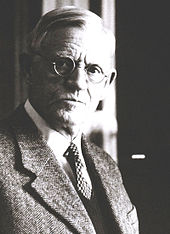Bernhard Karlgren
Klas Bernhard Johannes Karlgren (born October 5, 1889 in Jönköping , † October 20, 1978 in Stockholm ; Chinese pseudonym 高 本 漢 / 高 本 汉 , Gāo Běnhàn ) was a Swedish linguist and sinologist who was one of the first to try to understand the sound system of the middle and Reconstruct Old Chinese ( Karlgren-Li Reconstruction of Central Chinese ). Karlgren was director of the East Asian Museum from 1939 to 1959in Stockholm. In 1968 he was elected a corresponding member of the British Academy .
He applied the methods of European historical linguistics to Chinese . As a basis for his reconstruction , he used old rhyming dictionaries, which reproduced the phonological categories of the standard language of the time, and filled their categories with data that he gained from studying modern dialects and Chinese loanwords in other languages ( Japanese , Korean , Vietnamese ).
His attempts at reconstruction were groundbreaking for Chinese linguistics. Karlgren rejected methodological innovations in linguistics (especially structuralism , which he regarded as a passing fashion) and his working methods and results were later heavily criticized. Nevertheless, they form the basis of all recent research in the field of the historical phonology of Chinese and related languages.
Many of his publications appeared in the Bulletin of the Museum of Far Eastern Antiquities (BMFEA).
Works (selection)
- Etudes sur la phonologie chinoise . 1915–1926 ( Archives d'Études Orientales ).
- Ordet och Pennan i Mittens Rike, 1918, adapted as Sound and Symbol in Chinese . Oxford 1923. Reprinted by Global Language Press, Toronto 2007, ISBN 978-0-9738-9240-6 .
- The Reconstruction of Ancient Chinese . T'oung Pao , vol. 21, pp. 1-42, 1922
- Analytic Dictionary of Chinese and Sino-Japanese . 1923.
- Philology and Ancient China. Oslo u. a. 1926 ( digitized version )
- The Authenticity of Ancient Chinese Texts . in: Bulletin of the Museum of Far Eastern Antiquities, 1929.
- The Early History of the Chou Li and Tso Chuan Texts in: Bulletin of the Museum of Far Eastern Antiquities, 1931.
- Word Families in Chinese in: Bulletin of the Museum of Far Eastern Antiquities, 1933.
- New Studies on Chinese Bronzes in: Bulletin of the Museum of Far Eastern Antiquities, 1937.
- Grammata Serica, Script and Phonetics in Chinese and Sino-Japanese in: The Bulletin of the Museum of Far Eastern Antiquities, Stockholm, 1940.
- Huai and Han . in: The Bulletin of the Museum of Far Eastern Antiquities, Stockholm, 1941.
- Glosses on the Kuo Feng Odes . in: The Bulletin of the Museum of Far Eastern Antiquities, Stockholm, 1942.
- Glosses on the Siao Ya Odes . in: The Bulletin of the Museum of Far Eastern Antiquities, Stockholm, 1944.
- Glosses on the Ta Ya and Sung Odes . in: The Bulletin of the Museum of Far Eastern Antiquities, Stockholm, 1946.
- Legends and Cults in Ancient China . in: The Bulletin of the Museum of Far Eastern Antiquities, Stockholm, 1946.
- The Book of Documents . in: The Bulletin of the Museum of Far Eastern Antiquities, Stockholm, 1950.
- Compendium of Phonetics in Ancient and Archaic Chinese . in: The Bulletin of the Museum of Far Eastern Antiquities, Stockholm, 1954.
- Grammata Serica Recensa . in: The Bulletin of the Museum of Far Eastern Antiquities, Stockholm, 1957
- Glosses on the Tso Chuan . in: The Bulletin of the Museum of Far Eastern Antiquities, Stockholm, 1969.
References and footnotes
- ^ Deceased Fellows. British Academy, accessed June 16, 2020 .
- ↑ digital copies
literature
- NGD Malmqvist : Bernhard Karlgren: Portrait of a Scholar. 2010 ( partial online view )
Web links
- Literature by and about Bernhard Karlgren in the catalog of the German National Library
| personal data | |
|---|---|
| SURNAME | Karlgren, Bernhard |
| ALTERNATIVE NAMES | Karlgren, Klas Bernhard Johannes (full name) |
| BRIEF DESCRIPTION | Swedish sinologist |
| DATE OF BIRTH | October 5, 1889 |
| PLACE OF BIRTH | Jonkoping |
| DATE OF DEATH | October 20, 1978 |
| Place of death | Stockholm |
